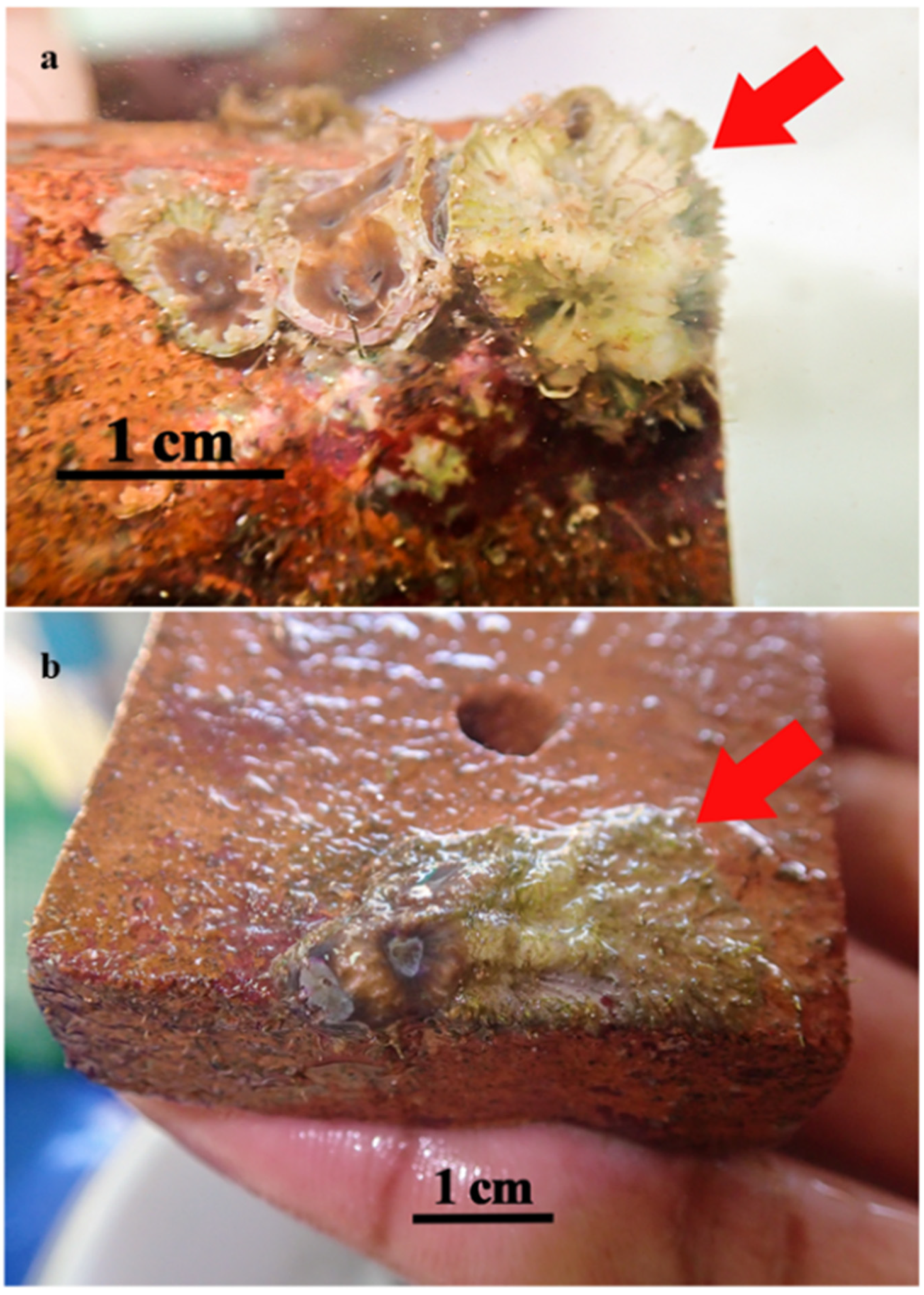First Report of Potential Coral Disease in the Coral Hatchery of Thailand
Abstract
:Author Contributions
Funding
Institutional Review Board Statement
Informed Consent Statement
Data Availability Statement
Acknowledgments
Conflicts of Interest
References
- Bourne, D.G.; Iida, Y.; Uthicke, S.; Smith-Keune, C. Changes in coral-associated microbial communities during a bleaching event. ISME J. 2008, 2, 350–363. [Google Scholar] [CrossRef] [PubMed]
- Gunalan, B.; Soundarapandian, P.; Dinakaran, G.K. The effect of temperature and pH on WSSV infection in cultured marine shrimp. Penaeus monodon (Fabricius). Middle East J. Sci. Res. 2010, 5, 28–33. [Google Scholar]
- Toledo-Hernández, C.; Ruiz-Diaz, C.P. The immune responses of the coral. Invertebr. Surviv. J. 2014, 11, 319–328. [Google Scholar]
- Gavish, A.; Shapito, O.H.; Kramarsky-Winter, E.; Vardi, A. Microscale tracking of coral-vibrio interactions. ISME Commun. 2021, 1, 18. [Google Scholar] [CrossRef]
- Bulan, D.E.; Wilantho, S.; Tongsima, V.; Viyakarn, V.; Chavanich, S.; Somboonna, N. Microbial and small eukaryotes associated. with reefs in the upper Gulf of Thailand. Front. Mar. Sci. 2018, 5, 436. [Google Scholar] [CrossRef]
- Chavanich, S.; Viyakarn, V.; Loyjiw, T.; Pattaratamrong, P.; Chankong, A. Mass bleaching of soft coral, Sarcophyton spp. in Thailand and the role of temperature and salinity stress. ICES J. Mar. Sci. 2009, 66, 1515–1519. [Google Scholar] [CrossRef] [Green Version]
- Roder, C.; Arif, C.; Bayer, T.; Aranda, M.; Daniels, C.; Shibl, A.; Chavanich, S.; Voolstra, C.R. Bacterial profiling of white plague disease (WPD) in a comparative coral species framework. ISME J. 2014, 8, 31–39. [Google Scholar] [CrossRef] [PubMed] [Green Version]

Publisher’s Note: MDPI stays neutral with regard to jurisdictional claims in published maps and institutional affiliations. |
© 2021 by the authors. Licensee MDPI, Basel, Switzerland. This article is an open access article distributed under the terms and conditions of the Creative Commons Attribution (CC BY) license (https://creativecommons.org/licenses/by/4.0/).
Share and Cite
Jandang, S.; Bulan, D.E.; Chavanich, S.; Viyakarn, V.; Aiemsomboon, K.; Somboonna, N. First Report of Potential Coral Disease in the Coral Hatchery of Thailand. Diversity 2022, 14, 18. https://doi.org/10.3390/d14010018
Jandang S, Bulan DE, Chavanich S, Viyakarn V, Aiemsomboon K, Somboonna N. First Report of Potential Coral Disease in the Coral Hatchery of Thailand. Diversity. 2022; 14(1):18. https://doi.org/10.3390/d14010018
Chicago/Turabian StyleJandang, Suppakarn, Dewi E. Bulan, Suchana Chavanich, Voranop Viyakarn, Kornrawee Aiemsomboon, and Naraporn Somboonna. 2022. "First Report of Potential Coral Disease in the Coral Hatchery of Thailand" Diversity 14, no. 1: 18. https://doi.org/10.3390/d14010018
APA StyleJandang, S., Bulan, D. E., Chavanich, S., Viyakarn, V., Aiemsomboon, K., & Somboonna, N. (2022). First Report of Potential Coral Disease in the Coral Hatchery of Thailand. Diversity, 14(1), 18. https://doi.org/10.3390/d14010018






